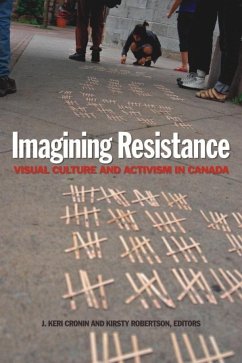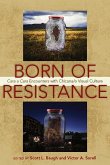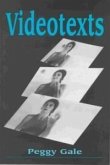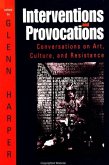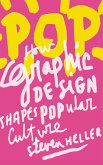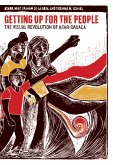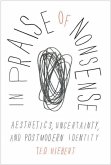Imagining Resistance
Visual Culture and Activism in Canada
Herausgeber: Cronin, J Keri; Robertson, Kirsty
Imagining Resistance
Visual Culture and Activism in Canada
Herausgeber: Cronin, J Keri; Robertson, Kirsty
- Broschiertes Buch
- Merkliste
- Auf die Merkliste
- Bewerten Bewerten
- Teilen
- Produkt teilen
- Produkterinnerung
- Produkterinnerung
Imagining Resistance: Visual Culture and Activism in Canada offers two separate but interconnected strategies for reading alternative culture in Canada from the 1940s through to the present: first, a history of radical artistic practice in Canada and, second, a collection of eleven essays that focus on a range of institutions, artists, events, and actions. The history of radical practice is spread through the book in a series of short interventions, ranging from the Refus global to anarchist-inspired art, and from Aboriginal curatorial interventions to culture jamming. In each, the historical…mehr
Andere Kunden interessierten sich auch für
![Born of Resistance Born of Resistance]() Born of Resistance37,99 €
Born of Resistance37,99 €![Videotexts Videotexts]() Peggy GaleVideotexts39,99 €
Peggy GaleVideotexts39,99 €![Interventions and Provocations Interventions and Provocations]() Interventions and Provocations24,99 €
Interventions and Provocations24,99 €![Pop Pop]() Steven HellerPop19,99 €
Steven HellerPop19,99 €![Getting Up for the People Getting Up for the People]() Mike Graham De La RosaGetting Up for the People17,99 €
Mike Graham De La RosaGetting Up for the People17,99 €![The Reality Shows The Reality Shows]() Karen FinleyThe Reality Shows14,99 €
Karen FinleyThe Reality Shows14,99 €![In Praise of Nonsense: Aesthetics, Uncertainty, and Postmodern Identity In Praise of Nonsense: Aesthetics, Uncertainty, and Postmodern Identity]() Ted HiebertIn Praise of Nonsense: Aesthetics, Uncertainty, and Postmodern Identity33,99 €
Ted HiebertIn Praise of Nonsense: Aesthetics, Uncertainty, and Postmodern Identity33,99 €-
-
-
Imagining Resistance: Visual Culture and Activism in Canada offers two separate but interconnected strategies for reading alternative culture in Canada from the 1940s through to the present: first, a history of radical artistic practice in Canada and, second, a collection of eleven essays that focus on a range of institutions, artists, events, and actions. The history of radical practice is spread through the book in a series of short interventions, ranging from the Refus global to anarchist-inspired art, and from Aboriginal curatorial interventions to culture jamming. In each, the historical record is mined to rewrite and reverse Canadian art history - reworked here to illuminate the series of oppositional artistic endeavours that are often mentioned in discussions of Canadian art but rarely acknowledged as having an alternative history of their own. Alongside, authors consider case studies as diverse as the anti-war work done by John Lennon and Yoko Ono in Montreal and Toronto, recent exhibitions of activist art in Canadian institutions, radical films, performance art, protests against the Olympics, interventions into anti-immigrant sentiment in Montreal, and work by Iroquois photographer Jeff Thomas. Taken together, the writings in Imagining Resistance touch on the local, the global, the national, and post-national to imagine a very different landscape of cultural practice in Canada.
Produktdetails
- Produktdetails
- Verlag: Wilfrid Laurier University Press
- Seitenzahl: 294
- Erscheinungstermin: 26. April 2011
- Englisch
- Abmessung: 226mm x 152mm x 20mm
- Gewicht: 431g
- ISBN-13: 9781554582570
- ISBN-10: 1554582571
- Artikelnr.: 31281932
- Herstellerkennzeichnung
- Libri GmbH
- Europaallee 1
- 36244 Bad Hersfeld
- gpsr@libri.de
- Verlag: Wilfrid Laurier University Press
- Seitenzahl: 294
- Erscheinungstermin: 26. April 2011
- Englisch
- Abmessung: 226mm x 152mm x 20mm
- Gewicht: 431g
- ISBN-13: 9781554582570
- ISBN-10: 1554582571
- Artikelnr.: 31281932
- Herstellerkennzeichnung
- Libri GmbH
- Europaallee 1
- 36244 Bad Hersfeld
- gpsr@libri.de
J. Keri Cronin is an assistant professor in the Visual Arts Department at Brock University. She is also a faculty affiliate in Brock's Social Justice & Equity Studies Graduate Program, the editor of The Brock Review, and part of the organizing committee for Greenscapes, a biennial conference on the cultural history of gardens held at Brock University. She is the author of Manufacturing National Park Nature: Photography, Ecology and the Wilderness Industry of Jasper National Park (2010). Kirsty Robertson is a professor of contemporary art and museum studies at the University of Western Ontario. She has published widely in her two major areas of research, globalization, creative industries and activism; and the study of wearable technologies, immersive environments, and the potential overlap(s) between textiles and technologies. She is completing her manuscript Tear Gas Epiphanies: New Economies of Protest, Vision and Culture in Canada.
Table of Contents for
Imagining Resistance: Visual Culture and Activism in Canada, edited by J.
Keri Cronin and Kirsty Robertson
List of Figures
Acknowledgments
Imagining Resistance: An Introduction Kirsty Robertson and J. Keri Cronin
Refus Global
Speaking Pie to Power: Can We Resist the Historic Compromise of Neoliberal
Art? Gregory Sholette
Canadian Artists' Representation and Copyright
John and Yoko's Media War for Peace Louis Kaplan
Carol Condé and Karl Beveridge: A Living Culture Needs a Living Wage
Monumental Interventions: Jeffrey Thomas Seizes Commemorative Space
Claudette Lauzon
General Idea and AIDS
Resistant Performers and Engaged/ing Public(s) Jessica Wyman
"The Named and the Unnamed": Gendering the Canadian Art Scene
Borders in the City Ayesha Hameed
Crisis of Representation: Multiculturalism, Minquon Panchyat and "The Lands
Within Me"
Bread and Five Ring Circuses: Art, Activism, and the Olympic Games in
Vancouver and London Kirsten Forkert
Aboriginal Representation and the Canadian Art World
APEC at the Museum of Anthropology: The Politics of Site and the Poetics of
Sight Bite Ruth B. Phillips
Culture Jamming
Titanium Motherships of the New Economy: Museums, Neoliberalism, and
Resistance Kirsty Robertson
Anarchy
Behind the Mask/I Am the Other: Solidarity and Struggle in The Fourth World
War David Jefferess
Gentrification
Toward a Conclusion: A Focus on the Visual Culture of Activism J. Keri
Cronin
Bibliography
Contributors
Index
Contributors' Bios
J. Keri Cronin is an assistant professor in the Department of Visual Arts
at Brock University. She is also a faculty affiliate in Brock's Social
Justice and Equity Studies graduate programand the editor of The Brock
Review. She is the author of Manufacturing National Park Nature:
Photography, Ecology, and the Wilderness Industry of Jasper National Park
(2011).
Kirsten Forkert is a researcher and activist based in London,UK. She is
currently pursuing a Ph.D. in Media and Communications at Goldsmiths
College, University of London. Her recent writing, dealing with topics such
as cultural policy, cultural activism and the politics of education, has
been published in Mute, Variant, Chto Delat, and Third Text.
Ayesha Hameed is an FQRSC Postdoctoral Fellow at the Centre for Research
Architecture at Goldsmiths, University of London. Her Ph.D.was completed at
the Graduate Programme in Social and Political Thought at York University,
where her dissertation, "Bricks and Blood: The Dialectical Image of The
Black Atlantic in The Colonial Metropolis," was nominated for the Faculty
of Graduate Studies Dissertation Prize. Hameed's video and performance work
focuses on borders in the context of sans-papiers organizing and migrant
subjectivity. She has presented her work at the Banff Centre for the Arts,
OBORO Gallery Montreal, Montréal Arts Interculturels (MAI), the HTMlles
Festival, ISEA and elsewhere. Hameed is a former board member of Fuse
magazine, and her writing has been published in journals like Public and
Topia as well as in collections such as PLACE: Location and Belonging in
New Media Contexts. www.ayeshahameed.net.
David Jefferess teaches English and Cultural Studies at the University of
British Columbia Okanagan. He has published articles that provide
postcolonial analysis of human rights, humanitarianism, global citizenship,
and Western representations of the Global South. His book Postcolonial
Resistance: Culture, Liberation, and Transformation was published in 2008,
and his current project focuses on the discourse of benevolence and the
figure of humanity.
Louis Kaplan is a professor of history and theory of photography and new
media in the Graduate Department of Art at the University of Toronto and
the chair of the new Department of Visual Studies at the University of
Toronto, Mississauga. He has published widely in photography studies and on
the relationship between contemporary art and media culture. His books
include Laszlo Moholy-Nagy: Biographical Writings (1995), American
Exposures: Photography and Community in the Twentieth Century (2005), and
The Strange Case of William Mumler, Spirit Photographer (2008). With John
Paul Ricco, he co-edited the special issue "Regarding Jean-Luc Nancy" for
the Journal of Visual Culture in the spring of 2010. His essay on the
photoscrolls of Patrick Clancy will be published in a forthcoming issue of
History of Photography. Louis Kaplan is currently working on the Verifax
photo-collages of Wallace Berman in the 1960s and their relations to both
counter-culture and Kabbalah.
Claudette Lauzon is a postdoctoral fellow in the Department of Art at
Cornell University. Her current research project, "Troubled Icons: Trauma,
Eyewitness Photography, and Contemporary Art," examines the ways in which
artists appropriate iconic photographs of suffering. Recent publications
include "What the Body Remembers: Rebecca Belmore's Memorial to Missing
Women," in Precarious Visualities: New Perspectives on Identification in
Contemporary Art and Visual Culture, edited by Olivier Asselin, Johanne
Lamoureux, and Christine Ross (2008).
Ruth Phillips is a Canada Research Chair in Modern Culture at Carleton
University. Her new research centres on two book projects, whose working
titles are Museum Pieces: Exhibiting Native Art in Canadian Museums, and
Transmission and Translation: Visuality and Art in the Great Lakes. She is
also establishing a Visual Studies Laboratory with grants from the Canada
Foundation for Innovation and the Ontario Innovation Fund that will enable
her to work with students, Aboriginal researchers, and colleagues in North
America and Europe to develop a data base of Great Lakes and Northeast art
and material culture and a virtual archive of Canadian exhibits that
address the arts and cultures of indigenous and diasporic communities.
Kirsty Robertson is an assistant professor of contemporary art and museum
studies at the University of Western Ontario. Robertson's research focuses
on activism, visual culture and changing economies. She has published
widely on the topic and is currently finishing her book Tear Gas
Epiphanies: New Economies of Protest, Vision and Culture in Canada. More
recently, she has turned her attention to the study of wearable
technologies, immersive environments and the potential overlap(s) between
textiles and technologies. She considers these issues within the framework
of globalization, activism, and burgeoning "creative economies."
Robertson's work can be found in journals such as The Communication Review
, Textile, Fuse magazine, n.paradoxa, and Globalisations and books such as
Fluid Screens, Expanded Cinema, Extra/Ordinary: Craft Culture and
Contemporary Art, and Constituent Imagination: Militant Investigations,
Collecive Theorization.
Gregory Sholette is a New York-based artist, writer, and founding member of
two artists' collectives: Political Art Documentation/Distribution (PAD/D:
1980-1988), and REPOhistory (1989-2000). His recent publications include
Dark Matter: art and Politics in the Age of Enterprise Culture (2010);
Collectivism after Modernism: The Art of Social Imagination after 1945,
co-edited with Blake Stimson (2007); The Interventionists: A Users' Manual
for the Creative Disruption of Everyday Life, co-edited with Nato Thompson
(2004, 2006, 2008); and a special issue of the journal Third Text
co-edited with Gene Ray entitled "Whither Tactical Media." Sholette is an
assistant professor of sculpture at Queens College, the City University of
New York (CUNY), a visiting faculty member at Harvard University, and
teaches an annual seminar in theory and social practice for the CCC
post-graduate research program at Geneva University of Art and Design.
Jessica Wyman is assistant professor in the faculties of Liberal Studies
and Art at Ontario College of Art and Design. She has worked with many
artistrun centres and publications, is currently a contributing editor to
Fuse magazine and sits on the board of directors of the Toronto Arts
Council. In 2004, Wyman was honoured with the Emerging Curator Award and a
nomination for Best Art Writing by the Untitled Art Awards. In 2009, Wyman
was Contemporary Curator-in-Residence at the McIntosh Gallery at the
University of Western Ontario. Her writing on contemporary art has been
published internationally in magazines and journals, including Springer
Kunst, Fuse, Ciel Variable, Open Letter, Women's Art Magazine, and
Performance Research. In 2007, Wyman's three-volume edited book Pro Forma:
visual art/language/text was published by YYZBooks. Her current research
considers performative theory and adaptation in contemporary art, with an
essay on the topic published in Adaptation Theories, edited by Jillian
Saint Jacques (2010).
Imagining Resistance: Visual Culture and Activism in Canada, edited by J.
Keri Cronin and Kirsty Robertson
List of Figures
Acknowledgments
Imagining Resistance: An Introduction Kirsty Robertson and J. Keri Cronin
Refus Global
Speaking Pie to Power: Can We Resist the Historic Compromise of Neoliberal
Art? Gregory Sholette
Canadian Artists' Representation and Copyright
John and Yoko's Media War for Peace Louis Kaplan
Carol Condé and Karl Beveridge: A Living Culture Needs a Living Wage
Monumental Interventions: Jeffrey Thomas Seizes Commemorative Space
Claudette Lauzon
General Idea and AIDS
Resistant Performers and Engaged/ing Public(s) Jessica Wyman
"The Named and the Unnamed": Gendering the Canadian Art Scene
Borders in the City Ayesha Hameed
Crisis of Representation: Multiculturalism, Minquon Panchyat and "The Lands
Within Me"
Bread and Five Ring Circuses: Art, Activism, and the Olympic Games in
Vancouver and London Kirsten Forkert
Aboriginal Representation and the Canadian Art World
APEC at the Museum of Anthropology: The Politics of Site and the Poetics of
Sight Bite Ruth B. Phillips
Culture Jamming
Titanium Motherships of the New Economy: Museums, Neoliberalism, and
Resistance Kirsty Robertson
Anarchy
Behind the Mask/I Am the Other: Solidarity and Struggle in The Fourth World
War David Jefferess
Gentrification
Toward a Conclusion: A Focus on the Visual Culture of Activism J. Keri
Cronin
Bibliography
Contributors
Index
Contributors' Bios
J. Keri Cronin is an assistant professor in the Department of Visual Arts
at Brock University. She is also a faculty affiliate in Brock's Social
Justice and Equity Studies graduate programand the editor of The Brock
Review. She is the author of Manufacturing National Park Nature:
Photography, Ecology, and the Wilderness Industry of Jasper National Park
(2011).
Kirsten Forkert is a researcher and activist based in London,UK. She is
currently pursuing a Ph.D. in Media and Communications at Goldsmiths
College, University of London. Her recent writing, dealing with topics such
as cultural policy, cultural activism and the politics of education, has
been published in Mute, Variant, Chto Delat, and Third Text.
Ayesha Hameed is an FQRSC Postdoctoral Fellow at the Centre for Research
Architecture at Goldsmiths, University of London. Her Ph.D.was completed at
the Graduate Programme in Social and Political Thought at York University,
where her dissertation, "Bricks and Blood: The Dialectical Image of The
Black Atlantic in The Colonial Metropolis," was nominated for the Faculty
of Graduate Studies Dissertation Prize. Hameed's video and performance work
focuses on borders in the context of sans-papiers organizing and migrant
subjectivity. She has presented her work at the Banff Centre for the Arts,
OBORO Gallery Montreal, Montréal Arts Interculturels (MAI), the HTMlles
Festival, ISEA and elsewhere. Hameed is a former board member of Fuse
magazine, and her writing has been published in journals like Public and
Topia as well as in collections such as PLACE: Location and Belonging in
New Media Contexts. www.ayeshahameed.net.
David Jefferess teaches English and Cultural Studies at the University of
British Columbia Okanagan. He has published articles that provide
postcolonial analysis of human rights, humanitarianism, global citizenship,
and Western representations of the Global South. His book Postcolonial
Resistance: Culture, Liberation, and Transformation was published in 2008,
and his current project focuses on the discourse of benevolence and the
figure of humanity.
Louis Kaplan is a professor of history and theory of photography and new
media in the Graduate Department of Art at the University of Toronto and
the chair of the new Department of Visual Studies at the University of
Toronto, Mississauga. He has published widely in photography studies and on
the relationship between contemporary art and media culture. His books
include Laszlo Moholy-Nagy: Biographical Writings (1995), American
Exposures: Photography and Community in the Twentieth Century (2005), and
The Strange Case of William Mumler, Spirit Photographer (2008). With John
Paul Ricco, he co-edited the special issue "Regarding Jean-Luc Nancy" for
the Journal of Visual Culture in the spring of 2010. His essay on the
photoscrolls of Patrick Clancy will be published in a forthcoming issue of
History of Photography. Louis Kaplan is currently working on the Verifax
photo-collages of Wallace Berman in the 1960s and their relations to both
counter-culture and Kabbalah.
Claudette Lauzon is a postdoctoral fellow in the Department of Art at
Cornell University. Her current research project, "Troubled Icons: Trauma,
Eyewitness Photography, and Contemporary Art," examines the ways in which
artists appropriate iconic photographs of suffering. Recent publications
include "What the Body Remembers: Rebecca Belmore's Memorial to Missing
Women," in Precarious Visualities: New Perspectives on Identification in
Contemporary Art and Visual Culture, edited by Olivier Asselin, Johanne
Lamoureux, and Christine Ross (2008).
Ruth Phillips is a Canada Research Chair in Modern Culture at Carleton
University. Her new research centres on two book projects, whose working
titles are Museum Pieces: Exhibiting Native Art in Canadian Museums, and
Transmission and Translation: Visuality and Art in the Great Lakes. She is
also establishing a Visual Studies Laboratory with grants from the Canada
Foundation for Innovation and the Ontario Innovation Fund that will enable
her to work with students, Aboriginal researchers, and colleagues in North
America and Europe to develop a data base of Great Lakes and Northeast art
and material culture and a virtual archive of Canadian exhibits that
address the arts and cultures of indigenous and diasporic communities.
Kirsty Robertson is an assistant professor of contemporary art and museum
studies at the University of Western Ontario. Robertson's research focuses
on activism, visual culture and changing economies. She has published
widely on the topic and is currently finishing her book Tear Gas
Epiphanies: New Economies of Protest, Vision and Culture in Canada. More
recently, she has turned her attention to the study of wearable
technologies, immersive environments and the potential overlap(s) between
textiles and technologies. She considers these issues within the framework
of globalization, activism, and burgeoning "creative economies."
Robertson's work can be found in journals such as The Communication Review
, Textile, Fuse magazine, n.paradoxa, and Globalisations and books such as
Fluid Screens, Expanded Cinema, Extra/Ordinary: Craft Culture and
Contemporary Art, and Constituent Imagination: Militant Investigations,
Collecive Theorization.
Gregory Sholette is a New York-based artist, writer, and founding member of
two artists' collectives: Political Art Documentation/Distribution (PAD/D:
1980-1988), and REPOhistory (1989-2000). His recent publications include
Dark Matter: art and Politics in the Age of Enterprise Culture (2010);
Collectivism after Modernism: The Art of Social Imagination after 1945,
co-edited with Blake Stimson (2007); The Interventionists: A Users' Manual
for the Creative Disruption of Everyday Life, co-edited with Nato Thompson
(2004, 2006, 2008); and a special issue of the journal Third Text
co-edited with Gene Ray entitled "Whither Tactical Media." Sholette is an
assistant professor of sculpture at Queens College, the City University of
New York (CUNY), a visiting faculty member at Harvard University, and
teaches an annual seminar in theory and social practice for the CCC
post-graduate research program at Geneva University of Art and Design.
Jessica Wyman is assistant professor in the faculties of Liberal Studies
and Art at Ontario College of Art and Design. She has worked with many
artistrun centres and publications, is currently a contributing editor to
Fuse magazine and sits on the board of directors of the Toronto Arts
Council. In 2004, Wyman was honoured with the Emerging Curator Award and a
nomination for Best Art Writing by the Untitled Art Awards. In 2009, Wyman
was Contemporary Curator-in-Residence at the McIntosh Gallery at the
University of Western Ontario. Her writing on contemporary art has been
published internationally in magazines and journals, including Springer
Kunst, Fuse, Ciel Variable, Open Letter, Women's Art Magazine, and
Performance Research. In 2007, Wyman's three-volume edited book Pro Forma:
visual art/language/text was published by YYZBooks. Her current research
considers performative theory and adaptation in contemporary art, with an
essay on the topic published in Adaptation Theories, edited by Jillian
Saint Jacques (2010).
Table of Contents for
Imagining Resistance: Visual Culture and Activism in Canada, edited by J.
Keri Cronin and Kirsty Robertson
List of Figures
Acknowledgments
Imagining Resistance: An Introduction Kirsty Robertson and J. Keri Cronin
Refus Global
Speaking Pie to Power: Can We Resist the Historic Compromise of Neoliberal
Art? Gregory Sholette
Canadian Artists' Representation and Copyright
John and Yoko's Media War for Peace Louis Kaplan
Carol Condé and Karl Beveridge: A Living Culture Needs a Living Wage
Monumental Interventions: Jeffrey Thomas Seizes Commemorative Space
Claudette Lauzon
General Idea and AIDS
Resistant Performers and Engaged/ing Public(s) Jessica Wyman
"The Named and the Unnamed": Gendering the Canadian Art Scene
Borders in the City Ayesha Hameed
Crisis of Representation: Multiculturalism, Minquon Panchyat and "The Lands
Within Me"
Bread and Five Ring Circuses: Art, Activism, and the Olympic Games in
Vancouver and London Kirsten Forkert
Aboriginal Representation and the Canadian Art World
APEC at the Museum of Anthropology: The Politics of Site and the Poetics of
Sight Bite Ruth B. Phillips
Culture Jamming
Titanium Motherships of the New Economy: Museums, Neoliberalism, and
Resistance Kirsty Robertson
Anarchy
Behind the Mask/I Am the Other: Solidarity and Struggle in The Fourth World
War David Jefferess
Gentrification
Toward a Conclusion: A Focus on the Visual Culture of Activism J. Keri
Cronin
Bibliography
Contributors
Index
Contributors' Bios
J. Keri Cronin is an assistant professor in the Department of Visual Arts
at Brock University. She is also a faculty affiliate in Brock's Social
Justice and Equity Studies graduate programand the editor of The Brock
Review. She is the author of Manufacturing National Park Nature:
Photography, Ecology, and the Wilderness Industry of Jasper National Park
(2011).
Kirsten Forkert is a researcher and activist based in London,UK. She is
currently pursuing a Ph.D. in Media and Communications at Goldsmiths
College, University of London. Her recent writing, dealing with topics such
as cultural policy, cultural activism and the politics of education, has
been published in Mute, Variant, Chto Delat, and Third Text.
Ayesha Hameed is an FQRSC Postdoctoral Fellow at the Centre for Research
Architecture at Goldsmiths, University of London. Her Ph.D.was completed at
the Graduate Programme in Social and Political Thought at York University,
where her dissertation, "Bricks and Blood: The Dialectical Image of The
Black Atlantic in The Colonial Metropolis," was nominated for the Faculty
of Graduate Studies Dissertation Prize. Hameed's video and performance work
focuses on borders in the context of sans-papiers organizing and migrant
subjectivity. She has presented her work at the Banff Centre for the Arts,
OBORO Gallery Montreal, Montréal Arts Interculturels (MAI), the HTMlles
Festival, ISEA and elsewhere. Hameed is a former board member of Fuse
magazine, and her writing has been published in journals like Public and
Topia as well as in collections such as PLACE: Location and Belonging in
New Media Contexts. www.ayeshahameed.net.
David Jefferess teaches English and Cultural Studies at the University of
British Columbia Okanagan. He has published articles that provide
postcolonial analysis of human rights, humanitarianism, global citizenship,
and Western representations of the Global South. His book Postcolonial
Resistance: Culture, Liberation, and Transformation was published in 2008,
and his current project focuses on the discourse of benevolence and the
figure of humanity.
Louis Kaplan is a professor of history and theory of photography and new
media in the Graduate Department of Art at the University of Toronto and
the chair of the new Department of Visual Studies at the University of
Toronto, Mississauga. He has published widely in photography studies and on
the relationship between contemporary art and media culture. His books
include Laszlo Moholy-Nagy: Biographical Writings (1995), American
Exposures: Photography and Community in the Twentieth Century (2005), and
The Strange Case of William Mumler, Spirit Photographer (2008). With John
Paul Ricco, he co-edited the special issue "Regarding Jean-Luc Nancy" for
the Journal of Visual Culture in the spring of 2010. His essay on the
photoscrolls of Patrick Clancy will be published in a forthcoming issue of
History of Photography. Louis Kaplan is currently working on the Verifax
photo-collages of Wallace Berman in the 1960s and their relations to both
counter-culture and Kabbalah.
Claudette Lauzon is a postdoctoral fellow in the Department of Art at
Cornell University. Her current research project, "Troubled Icons: Trauma,
Eyewitness Photography, and Contemporary Art," examines the ways in which
artists appropriate iconic photographs of suffering. Recent publications
include "What the Body Remembers: Rebecca Belmore's Memorial to Missing
Women," in Precarious Visualities: New Perspectives on Identification in
Contemporary Art and Visual Culture, edited by Olivier Asselin, Johanne
Lamoureux, and Christine Ross (2008).
Ruth Phillips is a Canada Research Chair in Modern Culture at Carleton
University. Her new research centres on two book projects, whose working
titles are Museum Pieces: Exhibiting Native Art in Canadian Museums, and
Transmission and Translation: Visuality and Art in the Great Lakes. She is
also establishing a Visual Studies Laboratory with grants from the Canada
Foundation for Innovation and the Ontario Innovation Fund that will enable
her to work with students, Aboriginal researchers, and colleagues in North
America and Europe to develop a data base of Great Lakes and Northeast art
and material culture and a virtual archive of Canadian exhibits that
address the arts and cultures of indigenous and diasporic communities.
Kirsty Robertson is an assistant professor of contemporary art and museum
studies at the University of Western Ontario. Robertson's research focuses
on activism, visual culture and changing economies. She has published
widely on the topic and is currently finishing her book Tear Gas
Epiphanies: New Economies of Protest, Vision and Culture in Canada. More
recently, she has turned her attention to the study of wearable
technologies, immersive environments and the potential overlap(s) between
textiles and technologies. She considers these issues within the framework
of globalization, activism, and burgeoning "creative economies."
Robertson's work can be found in journals such as The Communication Review
, Textile, Fuse magazine, n.paradoxa, and Globalisations and books such as
Fluid Screens, Expanded Cinema, Extra/Ordinary: Craft Culture and
Contemporary Art, and Constituent Imagination: Militant Investigations,
Collecive Theorization.
Gregory Sholette is a New York-based artist, writer, and founding member of
two artists' collectives: Political Art Documentation/Distribution (PAD/D:
1980-1988), and REPOhistory (1989-2000). His recent publications include
Dark Matter: art and Politics in the Age of Enterprise Culture (2010);
Collectivism after Modernism: The Art of Social Imagination after 1945,
co-edited with Blake Stimson (2007); The Interventionists: A Users' Manual
for the Creative Disruption of Everyday Life, co-edited with Nato Thompson
(2004, 2006, 2008); and a special issue of the journal Third Text
co-edited with Gene Ray entitled "Whither Tactical Media." Sholette is an
assistant professor of sculpture at Queens College, the City University of
New York (CUNY), a visiting faculty member at Harvard University, and
teaches an annual seminar in theory and social practice for the CCC
post-graduate research program at Geneva University of Art and Design.
Jessica Wyman is assistant professor in the faculties of Liberal Studies
and Art at Ontario College of Art and Design. She has worked with many
artistrun centres and publications, is currently a contributing editor to
Fuse magazine and sits on the board of directors of the Toronto Arts
Council. In 2004, Wyman was honoured with the Emerging Curator Award and a
nomination for Best Art Writing by the Untitled Art Awards. In 2009, Wyman
was Contemporary Curator-in-Residence at the McIntosh Gallery at the
University of Western Ontario. Her writing on contemporary art has been
published internationally in magazines and journals, including Springer
Kunst, Fuse, Ciel Variable, Open Letter, Women's Art Magazine, and
Performance Research. In 2007, Wyman's three-volume edited book Pro Forma:
visual art/language/text was published by YYZBooks. Her current research
considers performative theory and adaptation in contemporary art, with an
essay on the topic published in Adaptation Theories, edited by Jillian
Saint Jacques (2010).
Imagining Resistance: Visual Culture and Activism in Canada, edited by J.
Keri Cronin and Kirsty Robertson
List of Figures
Acknowledgments
Imagining Resistance: An Introduction Kirsty Robertson and J. Keri Cronin
Refus Global
Speaking Pie to Power: Can We Resist the Historic Compromise of Neoliberal
Art? Gregory Sholette
Canadian Artists' Representation and Copyright
John and Yoko's Media War for Peace Louis Kaplan
Carol Condé and Karl Beveridge: A Living Culture Needs a Living Wage
Monumental Interventions: Jeffrey Thomas Seizes Commemorative Space
Claudette Lauzon
General Idea and AIDS
Resistant Performers and Engaged/ing Public(s) Jessica Wyman
"The Named and the Unnamed": Gendering the Canadian Art Scene
Borders in the City Ayesha Hameed
Crisis of Representation: Multiculturalism, Minquon Panchyat and "The Lands
Within Me"
Bread and Five Ring Circuses: Art, Activism, and the Olympic Games in
Vancouver and London Kirsten Forkert
Aboriginal Representation and the Canadian Art World
APEC at the Museum of Anthropology: The Politics of Site and the Poetics of
Sight Bite Ruth B. Phillips
Culture Jamming
Titanium Motherships of the New Economy: Museums, Neoliberalism, and
Resistance Kirsty Robertson
Anarchy
Behind the Mask/I Am the Other: Solidarity and Struggle in The Fourth World
War David Jefferess
Gentrification
Toward a Conclusion: A Focus on the Visual Culture of Activism J. Keri
Cronin
Bibliography
Contributors
Index
Contributors' Bios
J. Keri Cronin is an assistant professor in the Department of Visual Arts
at Brock University. She is also a faculty affiliate in Brock's Social
Justice and Equity Studies graduate programand the editor of The Brock
Review. She is the author of Manufacturing National Park Nature:
Photography, Ecology, and the Wilderness Industry of Jasper National Park
(2011).
Kirsten Forkert is a researcher and activist based in London,UK. She is
currently pursuing a Ph.D. in Media and Communications at Goldsmiths
College, University of London. Her recent writing, dealing with topics such
as cultural policy, cultural activism and the politics of education, has
been published in Mute, Variant, Chto Delat, and Third Text.
Ayesha Hameed is an FQRSC Postdoctoral Fellow at the Centre for Research
Architecture at Goldsmiths, University of London. Her Ph.D.was completed at
the Graduate Programme in Social and Political Thought at York University,
where her dissertation, "Bricks and Blood: The Dialectical Image of The
Black Atlantic in The Colonial Metropolis," was nominated for the Faculty
of Graduate Studies Dissertation Prize. Hameed's video and performance work
focuses on borders in the context of sans-papiers organizing and migrant
subjectivity. She has presented her work at the Banff Centre for the Arts,
OBORO Gallery Montreal, Montréal Arts Interculturels (MAI), the HTMlles
Festival, ISEA and elsewhere. Hameed is a former board member of Fuse
magazine, and her writing has been published in journals like Public and
Topia as well as in collections such as PLACE: Location and Belonging in
New Media Contexts. www.ayeshahameed.net.
David Jefferess teaches English and Cultural Studies at the University of
British Columbia Okanagan. He has published articles that provide
postcolonial analysis of human rights, humanitarianism, global citizenship,
and Western representations of the Global South. His book Postcolonial
Resistance: Culture, Liberation, and Transformation was published in 2008,
and his current project focuses on the discourse of benevolence and the
figure of humanity.
Louis Kaplan is a professor of history and theory of photography and new
media in the Graduate Department of Art at the University of Toronto and
the chair of the new Department of Visual Studies at the University of
Toronto, Mississauga. He has published widely in photography studies and on
the relationship between contemporary art and media culture. His books
include Laszlo Moholy-Nagy: Biographical Writings (1995), American
Exposures: Photography and Community in the Twentieth Century (2005), and
The Strange Case of William Mumler, Spirit Photographer (2008). With John
Paul Ricco, he co-edited the special issue "Regarding Jean-Luc Nancy" for
the Journal of Visual Culture in the spring of 2010. His essay on the
photoscrolls of Patrick Clancy will be published in a forthcoming issue of
History of Photography. Louis Kaplan is currently working on the Verifax
photo-collages of Wallace Berman in the 1960s and their relations to both
counter-culture and Kabbalah.
Claudette Lauzon is a postdoctoral fellow in the Department of Art at
Cornell University. Her current research project, "Troubled Icons: Trauma,
Eyewitness Photography, and Contemporary Art," examines the ways in which
artists appropriate iconic photographs of suffering. Recent publications
include "What the Body Remembers: Rebecca Belmore's Memorial to Missing
Women," in Precarious Visualities: New Perspectives on Identification in
Contemporary Art and Visual Culture, edited by Olivier Asselin, Johanne
Lamoureux, and Christine Ross (2008).
Ruth Phillips is a Canada Research Chair in Modern Culture at Carleton
University. Her new research centres on two book projects, whose working
titles are Museum Pieces: Exhibiting Native Art in Canadian Museums, and
Transmission and Translation: Visuality and Art in the Great Lakes. She is
also establishing a Visual Studies Laboratory with grants from the Canada
Foundation for Innovation and the Ontario Innovation Fund that will enable
her to work with students, Aboriginal researchers, and colleagues in North
America and Europe to develop a data base of Great Lakes and Northeast art
and material culture and a virtual archive of Canadian exhibits that
address the arts and cultures of indigenous and diasporic communities.
Kirsty Robertson is an assistant professor of contemporary art and museum
studies at the University of Western Ontario. Robertson's research focuses
on activism, visual culture and changing economies. She has published
widely on the topic and is currently finishing her book Tear Gas
Epiphanies: New Economies of Protest, Vision and Culture in Canada. More
recently, she has turned her attention to the study of wearable
technologies, immersive environments and the potential overlap(s) between
textiles and technologies. She considers these issues within the framework
of globalization, activism, and burgeoning "creative economies."
Robertson's work can be found in journals such as The Communication Review
, Textile, Fuse magazine, n.paradoxa, and Globalisations and books such as
Fluid Screens, Expanded Cinema, Extra/Ordinary: Craft Culture and
Contemporary Art, and Constituent Imagination: Militant Investigations,
Collecive Theorization.
Gregory Sholette is a New York-based artist, writer, and founding member of
two artists' collectives: Political Art Documentation/Distribution (PAD/D:
1980-1988), and REPOhistory (1989-2000). His recent publications include
Dark Matter: art and Politics in the Age of Enterprise Culture (2010);
Collectivism after Modernism: The Art of Social Imagination after 1945,
co-edited with Blake Stimson (2007); The Interventionists: A Users' Manual
for the Creative Disruption of Everyday Life, co-edited with Nato Thompson
(2004, 2006, 2008); and a special issue of the journal Third Text
co-edited with Gene Ray entitled "Whither Tactical Media." Sholette is an
assistant professor of sculpture at Queens College, the City University of
New York (CUNY), a visiting faculty member at Harvard University, and
teaches an annual seminar in theory and social practice for the CCC
post-graduate research program at Geneva University of Art and Design.
Jessica Wyman is assistant professor in the faculties of Liberal Studies
and Art at Ontario College of Art and Design. She has worked with many
artistrun centres and publications, is currently a contributing editor to
Fuse magazine and sits on the board of directors of the Toronto Arts
Council. In 2004, Wyman was honoured with the Emerging Curator Award and a
nomination for Best Art Writing by the Untitled Art Awards. In 2009, Wyman
was Contemporary Curator-in-Residence at the McIntosh Gallery at the
University of Western Ontario. Her writing on contemporary art has been
published internationally in magazines and journals, including Springer
Kunst, Fuse, Ciel Variable, Open Letter, Women's Art Magazine, and
Performance Research. In 2007, Wyman's three-volume edited book Pro Forma:
visual art/language/text was published by YYZBooks. Her current research
considers performative theory and adaptation in contemporary art, with an
essay on the topic published in Adaptation Theories, edited by Jillian
Saint Jacques (2010).

